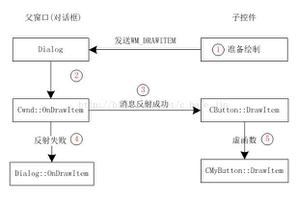petite-vue源码剖析-属性绑定`v-bind`的工作原理

关于指令(directive)
属性绑定、事件绑定和v-modal底层都是通过指令(directive)实现的,那么什么是指令呢?我们一起看看Directive的定义吧。
//文件 ./src/directives/index.tsexport interface Directive<T = Element> {
(ctx: DirectiveContext<T>): (() => void) | void
}
指令(directive)其实就是一个接受参数类型为DirectiveContext并且返回cleanup
函数或啥都不返回的函数。那么DirectiveContext有是如何的呢?
//文件 ./src/directives/index.tsexport interface DirectiveContext<T = Element> {
el: T
get: (exp?: string) => any // 获取表达式字符串运算后的结果
effect: typeof rawEffect // 用于添加副作用函数
exp: string // 表达式字符串
arg?: string // v-bind:value或:value中的value, v-on:click或@click中的click
modifiers?: Record<string, true> // @click.prevent中的prevent
ctx: Context
}
深入v-bind的工作原理
walk方法在解析模板时会遍历元素的特性集合el.attributes,当属性名称name匹配v-bind或:时,则调用processDirective(el, 'v-bind', value, ctx)对属性名称进行处理并转发到对应的指令函数并执行。
//文件 ./src/walk.ts// 为便于阅读,我将与v-bind无关的代码都删除了
const processDirective = (
el: Element,
raw, string, // 属性名称
exp: string, // 属性值:表达式字符串
ctx: Context
) => {
let dir: Directive
let arg: string | undefined
let modifiers: Record<string, true> | undefined // v-bind有且仅有一个modifier,那就是camel
if (raw[0] == ':') {
dir = bind
arg = raw.slice(1)
}
else {
const argIndex = raw.indexOf(':')
// 由于指令必须以`v-`开头,因此dirName则是从第3个字符开始截取
const dirName = argIndex > 0 ? raw.slice(2, argIndex) : raw.slice(2)
// 优先获取内置指令,若查找失败则查找当前上下文的指令
dir = builtInDirectives[dirName] || ctx.dirs[dirName]
arg = argIndex > 0 ? raw.slice(argIndex) : undefined
}
if (dir) {
// 由于ref不是用于设置元素的属性,因此需要特殊处理
if (dir === bind && arg === 'ref') dir = ref
applyDirective(el, dir, exp, ctx, arg, modifiers)
}
}
当processDirective根据属性名称匹配相应的指令和抽取入参后,就会调用applyDirective来通过对应的指令执行操作。
//文件 ./src/walk.tsconst applyDirective = (
el: Node,
dir: Directive<any>,
exp: string,
ctx: Context,
arg?: string
modifiers?: Record<string, true>
) => {
const get = (e = exp) => evaluate(ctx.scope, e, el)
// 指令执行后可能会返回cleanup函数用于执行资源释放操作,或什么都不返回
const cleanup = dir({
el,
get,
effect: ctx.effect,
ctx,
exp,
arg,
modifiers
})
if (cleanup) {
// 将cleanup函数添加到当前上下文,当上下文销毁时会执行指令的清理工作
ctx.cleanups.push(cleanup)
}
}
现在我们终于走到指令bind执行阶段了
//文件 ./src/directives/bind.ts// 只能通过特性的方式赋值的属性
const forceAttrRE = /^(spellcheck|draggable|form|list|type)$/
export const bind: Directive<Element & { _class?: string }> => ({
el,
get,
effect,
arg,
modifiers
}) => {
let prevValue: any
if (arg === 'class') {
el._class = el.className
}
effect(() => {
let value = get()
if (arg) {
// 用于处理v-bind:style="{color:'#fff'}" 的情况
if (modifiers?.camel) {
arg = camelize(arg)
}
setProp(el, arg, value, prevValue)
}
else {
// 用于处理v-bind="{style:{color:'#fff'}, fontSize: '10px'}" 的情况
for (const key in value) {
setProp(el, key, value[key], prevValue && prevValue[key])
}
// 删除原视图存在,而当前渲染的新视图不存在的属性
for (const key in prevValue) {
if (!value || !(key in value)) {
setProp(el, key, null)
}
}
}
prevValue = value
})
}
const setProp = (
el: Element & {_class?: string},
key: string,
value: any,
prevValue?: any
) => {
if (key === 'class') {
el.setAttribute(
'class',
normalizeClass(el._class ? [el._class, value] : value) || ''
)
}
else if (key === 'style') {
value = normalizeStyle(value)
const { style } = el as HTMLElement
if (!value) {
// 若`:style=""`则移除属性style
el.removeAttribute('style')
}
else if (isString(value)) {
if (value !== prevValue) style.cssText = value
}
else {
// value为对象的场景
for (const key in value) {
setStyle(style, key, value[key])
}
// 删除原视图存在,而当前渲染的新视图不存在的样式属性
if (prevValue && !isString(prevValue)) {
for (const key in prevValue) {
if (value[key] == null) {
setStyle(style, key, '')
}
}
}
}
}
else if (
!(el instanceof SVGElement) &&
key in el &&
!forceAttrRE.test(key)) {
// 设置DOM属性(属性类型可以是对象)
el[key] = value
// 留给`v-modal`使用的
if (key === 'value') {
el._value = value
}
} else {
// 设置DOM特性(特性值仅能为字符串类型)
/* 由于`<input v-modal type="checkbox">`元素的属性`value`仅能存储字符串,
* 通过`:true-value`和`:false-value`设置选中和未选中时对应的非字符串类型的值。
*/
if (key === 'true-value') {
;(el as any)._trueValue = value
}
else if (key === 'false-value') {
;(el as any)._falseValue = value
}
else if (value != null) {
el.setAttribute(key, value)
}
else {
el.removeAttribute(key)
}
}
}
const importantRE = /\s*!important/
const setStyle = (
style: CSSStyleDeclaration,
name: string,
val: string | string[]
) => {
if (isArray(val)) {
val.forEach(v => setStyle(style, name, v))
}
else {
if (name.startsWith('--')) {
// 自定义属性
style.setProperty(name, val)
}
else {
if (importantRE.test(val)) {
// 带`!important`的属性
style.setProperty(
hyphenate(name),
val.replace(importantRE, ''),
'important'
)
}
else {
// 普通属性
style[name as any] = val
}
}
}
}
总结
通过本文我们以后不单可以使用v-bind:style绑定单一属性,还用通过v-bind一次过绑定多个属性,虽然好像不太建议这样做>_<
后续我们会深入理解v-on事件绑定的工作原理,敬请期待。
以上是 petite-vue源码剖析-属性绑定`v-bind`的工作原理 的全部内容, 来源链接: utcz.com/z/380835.html







